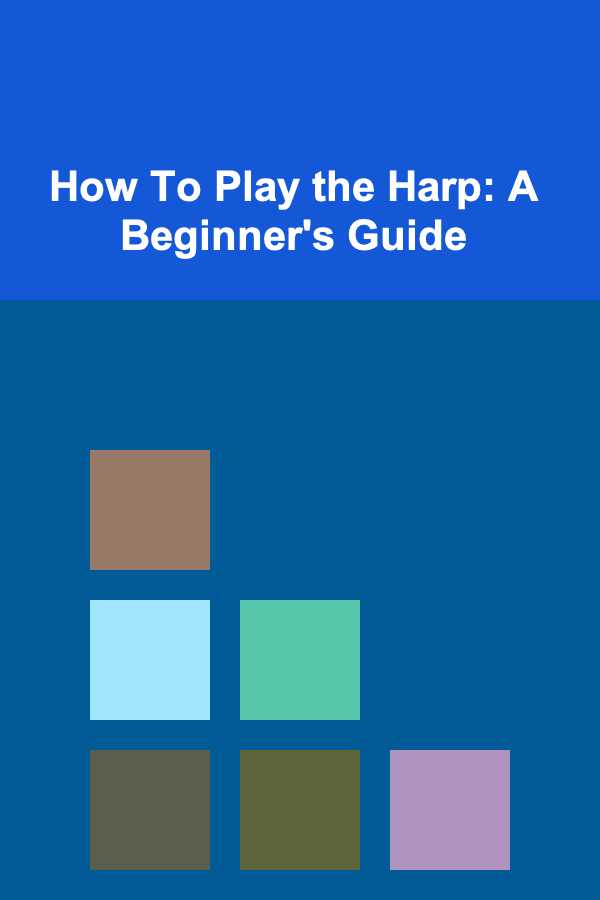
How To Play the Harp: A Beginner's Guide
ebook include PDF & Audio bundle (Micro Guide)
$12.99$6.99
Limited Time Offer! Order within the next:

The harp is one of the most ancient and enchanting instruments in the world. Its rich sound has captivated listeners for centuries, from the grand halls of European palaces to the small folk gatherings in various corners of the globe. The harp's delicate strings and its ethereal tones have an allure unlike any other instrument. If you are thinking of learning to play the harp, you are embarking on an exciting musical journey, one that connects you to a long history of musical artistry.
In this guide, we will walk you through the basics of how to play the harp, providing you with step-by-step instructions, helpful tips, and valuable insights into becoming a proficient harpist. Whether you are an absolute beginner or someone with some prior musical experience, this guide will give you a comprehensive understanding of the steps you need to take to master the harp.
The Harp: An Introduction
Before diving into playing, it's important to understand the harp itself. The harp consists of a large, triangular frame with strings stretched across it. The number of strings can vary, with the concert harp typically having 47 strings. These strings are tuned to different pitches, ranging from low notes at the bottom to high notes at the top. The harp is played by plucking the strings with the fingers, producing rich, resonant tones.
There are two main types of harps:
- Pedal Harp: This is the traditional, orchestral harp. It has 47 strings and uses a system of pedals that allow the player to change the pitch of certain strings, providing a wide range of musical possibilities.
- Lever Harp: Smaller and more portable than the pedal harp, the lever harp has fewer strings and is typically tuned using levers that adjust the pitch. It is popular for folk music and can be a great choice for beginners due to its simplicity.
For beginners, the lever harp is often the best starting point, as it is easier to handle, more affordable, and offers a more approachable learning curve.
Understanding the Harp's Anatomy
Before you start playing, it's essential to familiarize yourself with the different parts of the harp:
- Strings: These are the primary components of the harp. Each string corresponds to a different note and is made of various materials, such as nylon or gut. They are color-coded: C strings are typically red, and F strings are usually blue.
- Frame: The large, triangular body of the harp that holds the strings and provides the necessary resonance for sound production.
- Pedals or Levers: On pedal harps, pedals are used to alter the pitch of the strings, allowing you to play in different keys. Lever harps have levers on each string that can be adjusted to raise the pitch by a half-step.
- Soundboard: This is the flat wooden surface beneath the strings, which amplifies the vibrations and creates the harp's resonant sound.
- Top (or Neck): The top part of the harp where the strings are attached. The neck is often carved to enhance the instrument's aesthetics and resonance.
Getting Started with Your First Harp
Choosing the Right Harp
For a beginner, choosing the right harp is crucial. A lever harp is often the most suitable option as it is smaller, lighter, and more affordable than the full-sized pedal harp. Lever harps are versatile and can be used to play various styles of music, from classical to folk. However, if you have access to a full-sized pedal harp, you can certainly explore that option as well.
When selecting a harp, consider the following:
- Size: Make sure the harp fits comfortably in your space. If you plan to take it to lessons or performances, portability might be a factor in your decision.
- Sound Quality: Listen carefully to the sound of the harp before purchasing it. Harps with more strings will generally have a fuller sound, but each harp has its unique tonal quality.
- Budget: Harps can be expensive, but there are affordable options for beginners. Renting a harp or purchasing a used one can help reduce initial costs.
Tuning the Harp
Once you have your harp, the next step is learning how to tune it. Tuning is a fundamental skill for harpists, and it's essential to get comfortable with this process.
Each string on the harp corresponds to a specific pitch, and tuning ensures that all the strings are at the correct pitch. The most common method of tuning a harp is by using a tuning fork or an electronic tuner. Here's how you can tune the harp:
- Find the Correct Pitch: Start by tuning one string to a known pitch, such as middle C. Use a tuning fork, an app, or a piano to find the correct pitch.
- Tune Each String: Once you've tuned the first string, move on to the next string, adjusting it to the corresponding pitch. Continue this process for all the strings.
- Check for Correct Tuning: After tuning all the strings, go back and check each one. Sometimes strings can go out of tune during the process, so it's important to double-check your work.
Basic Techniques for Playing the Harp
Once your harp is tuned and ready, it's time to learn the basic techniques. The harp is a unique instrument because it requires both hands to work together, each performing different functions.
Hand Position and Plucking the Strings
Proper hand position is key to producing a beautiful sound. Start by positioning your hands above the strings with your fingers curved naturally, as if you were holding a ball. Your hands should be relaxed, and your wrists should be level with the strings to avoid tension.
- Plucking the Strings: To pluck a string, use the pads of your fingers, not your nails. Gently pull the string back toward your body, and release it to let it vibrate. The key is to produce a smooth, even sound without harshness.
- Finger Placement: Beginners should focus on using the thumb, index, and middle fingers to pluck the strings. Avoid using your pinky or ring fingers at first, as they are less coordinated for plucking.
Pedal or Lever Adjustments
If you're playing a lever harp, you'll adjust the pitch of each string using levers on the side of the harp. These levers raise the pitch of each string by a half-step. Familiarize yourself with the function of each lever before attempting to play.
On a pedal harp, the pedals change the pitch of multiple strings simultaneously, offering greater flexibility and the ability to play in various keys.
Basic Playing Positions
- Sitting Position: When sitting at the harp, make sure your posture is straight and comfortable. Sit up tall, with your feet flat on the ground and your arms relaxed. Your hands should be hovering just above the strings, ready to pluck them.
- Fingering Technique: Start with simple scales and exercises to build your finger strength and dexterity. A good way to develop your skills is to practice finger independence by plucking individual strings while keeping the other fingers still.
Learning to Read Music for the Harp
Harp music is written on a grand staff, similar to piano music, with both treble and bass clefs. Beginners should learn to read music and understand the notation used in harp music. Each note corresponds to a string on the harp, and the position of the note on the staff tells you which string to pluck.
- Treble Clef: The higher-pitched notes are written in the treble clef, and they correspond to the higher strings of the harp.
- Bass Clef: The lower-pitched notes are written in the bass clef, and they correspond to the lower strings of the harp.
Rhythms and Time Signatures
Understanding rhythms and time signatures is essential for playing the harp. Start by practicing simple rhythms, such as quarter notes, half notes, and whole notes. As you progress, you can explore more complex rhythms and time signatures, which will allow you to play a broader range of music.
Practice Routine and Tips for Beginners
Developing a practice routine is crucial for progress. Here's a simple practice plan for beginners:
- Warm-up: Spend the first 5--10 minutes of your practice session warming up your fingers. Play simple scales and arpeggios to get comfortable with the instrument.
- Technique Practice: Dedicate time to practicing plucking, hand positioning, and fingering. Practice slowly and focus on producing a clean, clear sound.
- Learning Music: Start with easy pieces and gradually increase the difficulty as you become more proficient. Break down the piece into small sections, and practice each section before putting it together.
- Sight-reading: Practice sight-reading new music regularly. This will help you become more comfortable reading and playing unfamiliar pieces.
- Stay Consistent: Consistent practice is key to improvement. Try to practice for at least 20--30 minutes each day.
Advanced Techniques and Beyond
As you progress, you'll learn more advanced techniques like hand crossing, playing harmonics, and incorporating complex pedal or lever changes into your playing. You may also begin exploring different styles of music, from classical to folk, Celtic, or contemporary music.
Joining a Community
One of the best ways to stay motivated and improve is to join a community of harpists. Whether it's through online forums, local classes, or social media, connecting with others who share your passion can be incredibly inspiring.
Conclusion
Learning to play the harp is a rewarding and fulfilling endeavor. Whether you are playing for personal enjoyment or pursuing a career as a harpist, mastering this beautiful instrument takes time, patience, and dedication. With the right techniques, practice routine, and a love for music, you'll be on your way to creating mesmerizing melodies on the harp.
So, take your first step today, tune your harp, position your hands, and begin plucking those strings---your journey toward becoming a harpist has just begun.

Effective Strategies for Medical Researchers: From Hypothesis to Breakthrough
Read More
How to Choose the Best Lighting for Your Home's Style
Read More
How to Maximize Closet and Storage Space in a Shared Room
Read More
How to Use Online Forums (Moderation) to Make Money
Read More
How to Use UI/UX Design Skills to Make Money
Read More
How Utilizing Shared Economy Services for Transportation Can Save You Money
Read MoreOther Products

Effective Strategies for Medical Researchers: From Hypothesis to Breakthrough
Read More
How to Choose the Best Lighting for Your Home's Style
Read More
How to Maximize Closet and Storage Space in a Shared Room
Read More
How to Use Online Forums (Moderation) to Make Money
Read More
How to Use UI/UX Design Skills to Make Money
Read More